Qualcomm is leading the innovation pipeline for 5G Advanced and beyond
For decades, Qualcomm has been at the forefront of spearheading pivotal wireless innovations. With 5G, we pioneered key inventions that were adopted into the first three standard releases (i.e., Release 15, Release 16, Release 17). And now, we stand at the cusp of the ASN.1 completion milestone of the first 5G Advanced standard — Release 18, targeted for June.
5G Advanced is not only poised to further unleash 5G’s full potential, but it will also establish 6G’s technical foundations, fueling future innovations in the decade to come. In this blog post, let me provide a closer look at several of Qualcomm’s key Release 18 technology pillars. I have distilled them into five key areas where Qualcomm played a leading role in driving these technologies forward. Today, our cutting-edge wireless research is propelling the evolution of 5G Advanced and laying the groundwork for 6G.
With Release 18, we introduce technological advancements that enhance device experiences, unlock network efficiencies and enable new system capabilities. These essential inventions in Release 18 establish a strong foundation for what’s to come next in wireless technology.
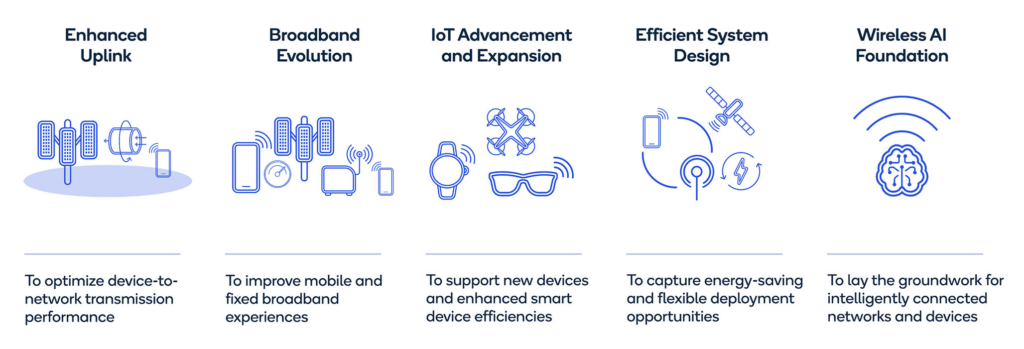
Qualcomm’s Release 18 invention areas.
Invention area #1: Enhanced uplink
One key Release 18 invention area focuses on enhancing performance for the uplink — transmissions from devices to networks. The uplink’s performance and reliability may be constrained by how much link budget is available for a device (e.g., a smartphone) to utilize for transmissions, largely attributed to device output power and propagation loss in the transmission path. This scenario is especially evident in the cell edge with new 5G midband spectrum (e.g., C-band in 3.5 GHz). Overcoming uplink challenges has been a crucial focus in developing 5G Advanced technologies. To improve user experience and system performance, Qualcomm led the way introducing several new capabilities in Release 18, including further improvements to uplink Multiple-Input Multiple-Output (MIMO) performance, which enhances device coverage and mobility, uplink transmit (Tx) switching, and dynamic power aggregation in carrier aggregation (CA).
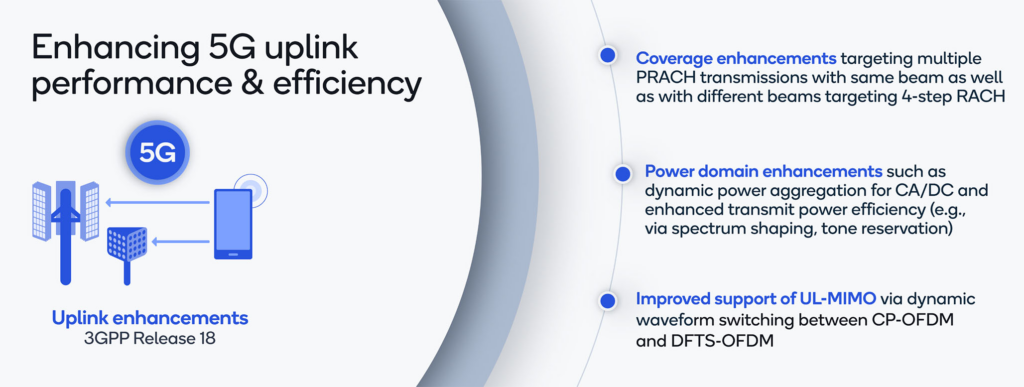
A few key uplink enhancements in 5G Advanced Release 18.
Invention area #2: Broadband evolution
Our mission to invent technologies enabling industry-leading wireless broadband performance continues with 5G Advanced. 3GPP Release 18 brought forth a multitude of system enhancements, not only pushing the limits of capacity and speed, but also delivering new capabilities that will benefit network operators and users alike. One important advancement area is the continued evolution of MIMO technology, and Release 18 can support more layers per device targeting mobile and fixed wireless access. Additionally, significant optimizations are made to device mobility management, ensuring a more seamless user experience during handover events. Release 18 also encompasses a wide range of other relevant performance and efficiency enhancements for broadband services, including dynamic spectrum sharing (DSS), CA, precise positioning and multi-SIM support.
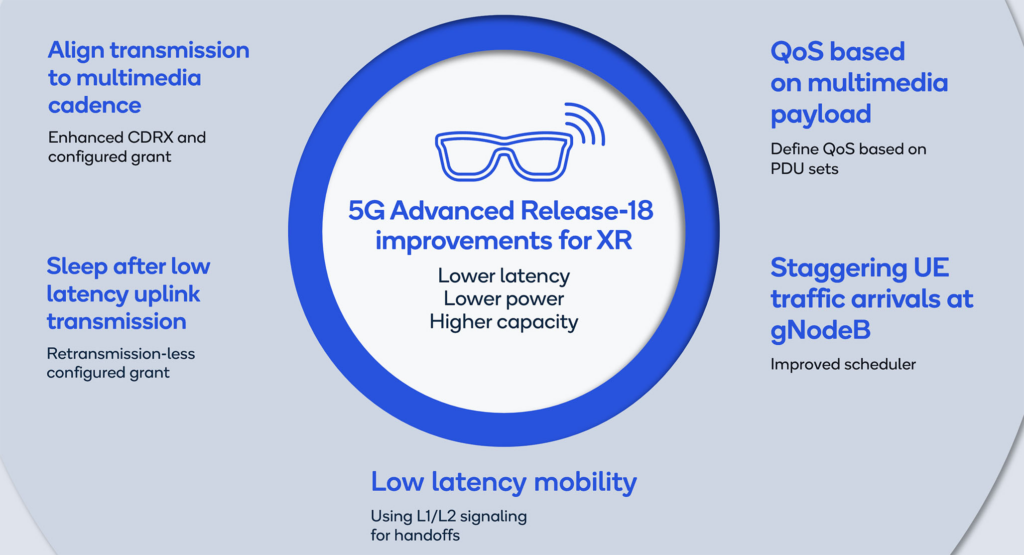
5G Advanced Release 18 further enhances XR capabilities and experiences.
Invention area #3: IoT advancement and expansion
A vital objective of the ongoing 5G Advanced technology evolution is to effectively drive the widespread adoption of 5G connectivity, empowering intelligent computing everywhere. Release 18 brings new 5G system capabilities that touch on a diverse set of applications. One key area is to enable more efficient low-tier and mid-tier Internet of Things (IoT) devices and services. This includes supporting enhanced Reduced Capability (RedCap) devices and small data transmission, as well as studying a new low-power wakeup receiver (LP-WUR). As many IoT services can also benefit from improved positioning performance and reliability, Release 18 also introduces positioning optimizations for devices with narrower bandwidths (e.g., 20 MHz) and sidelink positioning. For higher-performance IoT, Release 18 focuses on supporting enhanced drone communications and further optimizations for extended reality (XR), as illustrated above.
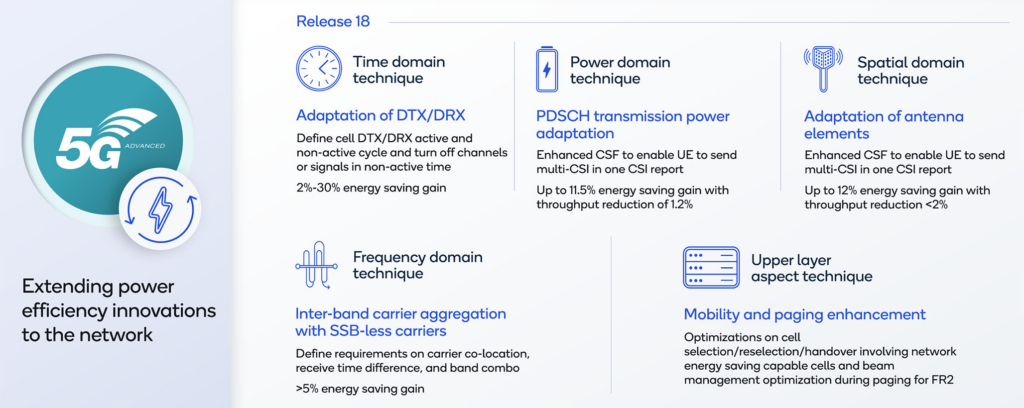
5G Advanced looks at new techniques to enable network energy savings.
Invention area #4: Efficient system design
5G Advanced takes a significant stride in delivering tangible benefits through improved operation, flexible deployment and spectrum utilization. Release 18 enhances operational efficiency with new network energy-saving techniques, building on previous innovations. For deployment efficiency, Release 18 expands the toolbox for cost-effective coverage expansion, supporting network-controlled repeater (NCR), mobile integrated access/backhaul, advanced sidelink operations (sidelink relay and NR-U sidelink), and 5G non-terrestrial network (NTN) enhancements. In terms of spectrum efficiency, Release 18 explores a new subband full duplex design, focusing on interference mitigation techniques that enable full duplex communication. Additionally, broadcast/multicast capabilities are enhanced for efficient simultaneous data transmission to multiple devices.
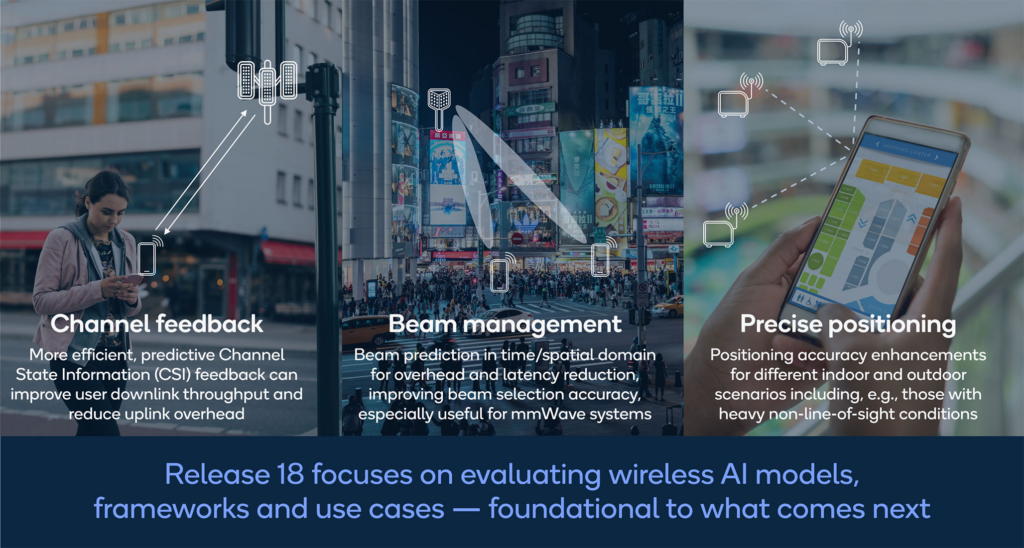
Wireless AI holds the potential to improve user experience and system efficiency.
Invention area #5: Wireless AI foundation
AI and wireless are two synergistic ingredients driving future technology innovations, and the recent surge in popularity of generative AI has sparked a global fervor surrounding the boundless possibilities that AI can unleash. For wireless advancements, AI techniques present a powerful solution to overcome difficult challenges such as optimizing for channel non-linearity. 5G Advanced kickstarts the new era of wireless AI in Release 18, focusing on the evaluation of AI models and frameworks that can seamlessly integrate into end-to-end wireless systems. This pivotal work lays the groundwork for forthcoming specifications in 5G Advanced Releases 19 and 20 as well as the highly anticipated AI-native 6G platform. Initial studies encompass several compelling use cases, including mobility optimization, as well as air interface use cases like channel feedback, beam management and positioning.
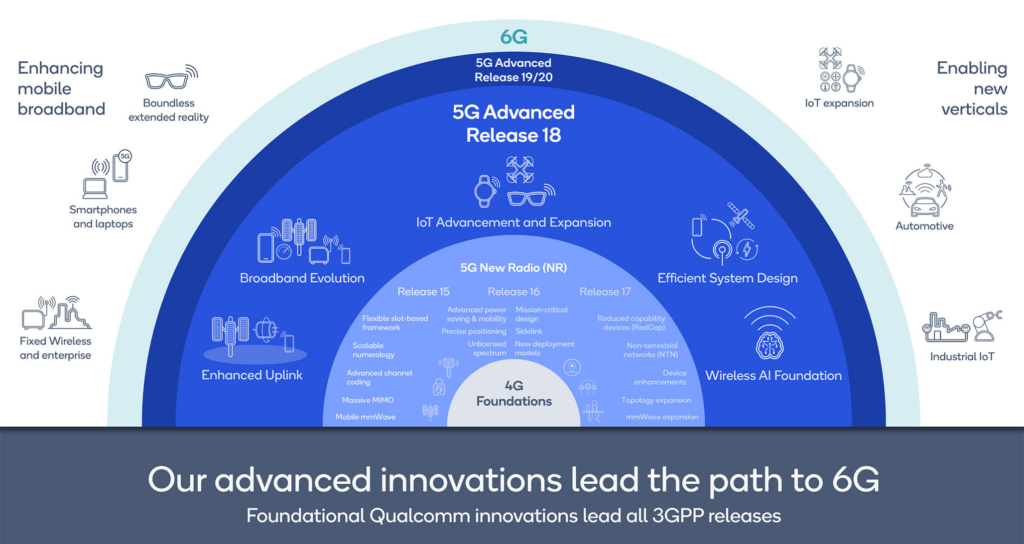
5G Advanced Release 18 builds on the strong 4G/5G wireless foundation.
What’s next?
As we near the completion of 3GPP Release 18, Qualcomm’s journey to drive the evolution of 5G Advanced is only just commencing. With an extensive scope of Release 19 projects already in motion, we are poised to propel 5G Advanced to new heights and establish a vital bridge to the future of 6G. At Qualcomm, we are thrilled to lead the charge in shaping the wireless industry, driving innovation that can enable new devices and services. Stay tuned for more exciting updates as we continue on our path towards the next generation of wireless technology.
Watch our latest wireless technology demonstrations
Learn more about the 5G Advanced technology evolution
Sign up for our wireless technologies newsletter to stay up to date

